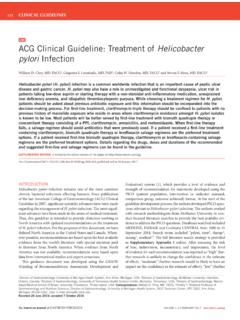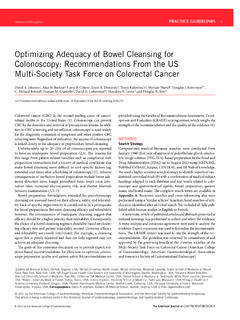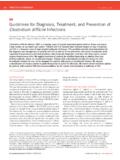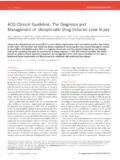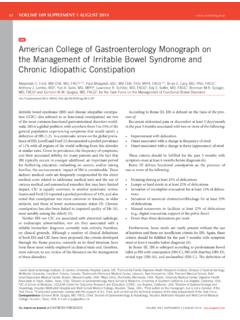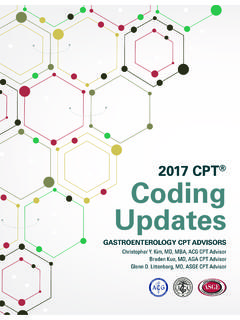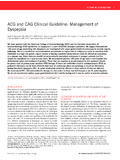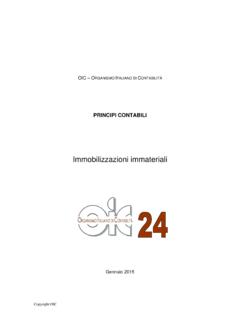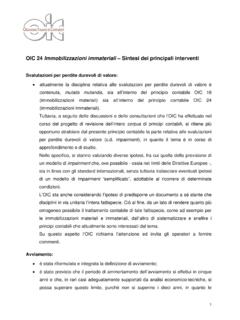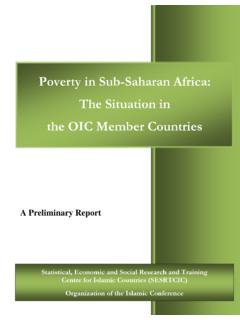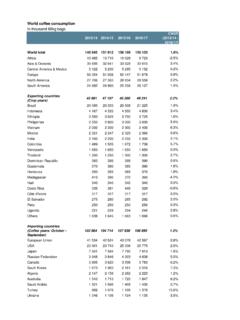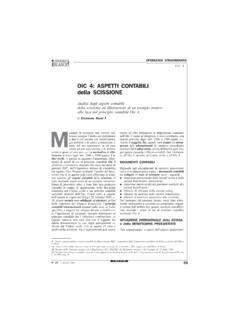Transcription of Opioid-Induced Constipation: Challenges and …
1 2011 by the American College of Gastroenterology The American Journal of GASTROENTEROLOGY nature publishing group835 REVIEW CLINICAL AND SYSTEMATIC REVIEWS INTRODUCTION Th ere has been an alarming increase in the prescription and chronic use of opiates and opioids for chronic non-cancer pain in the past 15 years. Th e objectives of this narrative review are to summarize essential aspects of the epidemiology of opiate- induced constipation (OIC), summarize the eff ects of opiates on gastrointestinal functions that lead to constipation , evaluate pharmacological approaches to treat or prevent OIC ( Table 1 ), and describe patient response outcome instruments being deve-loped for use in drug trials to relieve OIC. Th e main considera-tion was to provide practical information for clinicians managing OIC, and to introduce them to novel agents that are in develop-ment for this condition.
2 A search was conducted using the PUBMED electronic data-base (1966 to November 2010) using the following keywords and diff erent combinations: epidemiology, prevalence, opioids, opiates, opioid receptors, morphine, motility, secretion, gut, bowel, bowel dysfunction, constipation , and in addition hand searching the references of the individual papers retrieved. For NKTR-118 and TD-1211, a search was conducted in the public domain (using Google) for those specifi c drugs; data presented in abstracts at national meetings were appraised. opioid USE AND EPIDEMIOLOGY OF CHRONIC OIC Th e prevalence of chronic pain in the adult population ranges from 2 to 40 % , with a median point prevalence of 15 % ( 1 3 ). Chronic use of opioids for months or years for non-cancer pain is com-monly encountered in clinical practice. opioid analgesia treat-ment for severe pain is predictably effi cacious and improves level of function ( 4,5 ).
3 Prescription opiate use has increased sharply in many parts of the United States in the last decade ( 6 8 ), as it is a clinical imperative to inquire about and manage pain reported by patients. Increase in therapeutic opioid use in the United States is well documented ( 9 ), based on data from US Drug Enforce-ment Administration (( 10 ) Figure 1 ). Th e American Society of the Interventional Pain Physicians has issued guidelines for appropriate use of opioids ( 11 ). However, there is a rising tide of deaths from the fl ood of opioid use ( 12 ), with ~ 3 % of adults in the United States currently receiving long-term opioid therapy for chronic non-cancer pain ( 13 ). With the increased use of opioids, there are more patients pre-senting with OIC or opiate bowel dysfunction (OBD) ( 14,15 ). constipation may be debilitating among those who require chronic analgesia ( 16 ); OIC or OBD aff ected an average of 41 % patients taking an oral opioid for up to 8 weeks in a meta-analysis of 11 placebo-controlled, randomized studies in non-malignant pain ( 14 ).
4 Patients may discontinue treatment due to constipation , despite their established need for long-term pain relief. In a survey of patients taking opioid therapy for pain of non-cancer origin, who required laxative therapy, only 46 % of opi-oid-treated patients reported achieving the desired treatment results > 50 % of the time, in contrast to the reported satisfaction in 84 % of control subjects ( 17 ). Opioid-Induced constipation : Challenges and Therapeutic Opportunities Michael Camilleri , MD 1 There has been an alarming increase in the prescription of opiates and opioids for chronic non-cancer pain in the past 15 years. It is estimated that opiate- induced constipation (OIC) is experienced by ~ 40 % of these patients, and that constipation and other gastrointestinal symptoms may dissuade patients from using the required analgesic dose to achieve effective pain relief.
5 Opiates have several effects on gastrointestinal functions, and the inhibition of colonic transit and intestinal and colonic secretion results in constipation . Several different pharmacological approaches are being developed to prevent or treat OIC: prolonged release formulations that contain naloxone (a less specifi c opiate antagonist that is widely distributed) and a new class of peripherally restricted -opiate receptor antagonists, including methylnaltrexone, alvimopan, tapentadol, NKTR-118, and TD-1211. Novel patient response outcomes have been developed to facilitate demonstration of effi cacy and safety of drugs in development for OIC. Am J Gastroenterol 2011; 106:835 842; doi: ; published online 22 February 2011 1 Clinical Enteric Neuroscience Translational and Epidemiological Research, Mayo Clinic , Rochester , Minnesota , USA . Correspondence: Michael Camilleri, MD , Clinical Enteric Neuroscience Translational and Epidemiological Research, Mayo Clinic , Charlton 8-110, 200 First St SW, Rochester , Minnesota 55905 , USA.
6 E-mail: Received 22 December 2010; accepted 17 January 2011 CMEThe American Journal of GASTROENTEROLOGY VOLUME 106 | MAY 2011 Camilleri Among 100 ambulatory patients with moderate-to-severe chronic non-cancer pain, who returned a bowel disease survey and had taken opioids for a median of 1 year at a median daily dose of mg morphine-equivalent units, prevalence of constipation was % and chronic abdominal pain % . Prevalence of constipa-tion increased with duration of treatment. Health-related quality of life was low in patients with chronic abdominal pain ( 18 ). In the United States and European survey of 322 patients taking daily oral opioids and laxatives, 45 % of patients reported < 3 bowel movements per week, 81 % reported constipation , and 58 % strain-ing, symptoms were most oft en reported as severe, had at least a moderate negative impact on overall quality of life and activities of daily living, and a third of patients had missed, decreased, or stopped using opioids in order to make it easier to have a bowel movement ( 19 ).
7 -OPIATE RECEPTORS AND GASTROINTESTINAL FUNCTIONS Th ree types of receptors for opioid peptides have been identi-fi ed as having eff ects on human gastrointestinal function: -, -, and -receptors. Th ey all belong to the family of G-protein-cou-pled receptors, and inhibit adenylate cyclase. At the membrane level, they reduce neuronal excitability and neurotransmitter (acetylcholine) release ( 20 ) with an overall inhibitory eff ect on the neuron. opioid receptors are widely distributed in the central and peripheral nervous system, the intestinal musculature, and other tissues. Th e high concentrations of opioid receptors in the dorsal horn of the spinal cord relay aff erent nociceptive signals to the central nervous system ( 21 ), and those diff erent areas of the brain are involved in pain transmission ( 22 ). In the gastrointestinal tract, -receptors are widely distributed in the submucosa ( 23 ), as well as in the ileal mucosa where they infl uence ion transport changes ( 24 ).
8 Stomach and proximal colon have the most dense - and -opiate receptors ( 25 ). EFFECTS OF OPIATES THAT RESULT IN constipation Th e cause of constipation in opiate users is multi-factorial ( 26 ). Opioids interfere with normal gastrointestinal motility by delay-ing transit, stimulating non-propulsive motility, segmentation and tone, and stimulation of sphincters such as the pylorus and ileo-cecal sphincter ( 26 ) through their eff ects on enteric neurons ( 27 ). Opioids stimulate the absorption of fl uids, mainly by delayed transit increasing contact time for absorption, and by stimulating mucosal Table 1 . Summary of pharmacological approaches to treat opiate- induced constipation Drug name Drug class Pharmacodynamic effi cacy in humans Clinical trial optimal effi cacy and safety Naloxone Non-selective opioid antagonist Reverses opiate- induced delay in orocecal and colonic transit Naloxone PR formulation prevents OIC in patients receiving PR oxycodone Methylnaltrexone - opioid antagonist Reverses effects of opiate in health and of chronic methadone treatment on orocecal transit.
9 No effect on small intestinal or colonic transit delayed by codeine 30 mg in opiate-naive healthy subjects methylnaltrexone mg / kg on alternate days effective in inducing laxation in patients with advanced illness Alvimopan PAMORA 8 mg Oral dose accelerates colonic transit and reverse effects of codeine in opiate-nat ve healthy volunteers receiving codeine 30 mg mg Alvimopan dose effi cacious in treating OIC; rare instances of ischemic heart disease Tapentadol Narcotic analgesic plus norepinephrine reuptake inhibitor ND Tapentadol ER 100-250 mg equally effective for moderate to severe chronic osteoarthritis-related knee pain compared to oxycodone HCl (CR) 20 50 mg daily with less bowel dysfunction symptoms NKTR-118 PAMORA.
10 PEGylated naloxol conjugate Normalized morphine- induced delay in orocecal transit 25 and 50 mg NKTR-118 had increased number of SBM during the fi rst week and overall 4 weeks of treatment of OIC patients TD-1211 PAMORA ND 5 and 10 mg / day TD-1211 increased average SBM / week over 2 weeks in OIC patients CR, controlled release; ER, extended release; ND, not done; OIC, opiate- induced constipation ; PAMORA, peripherally-restricted - opioid receptor antagonist; PEG, polyethylene glycol; PR, prolonged release; SBM, spontaneous bowel movement; , subcutaneous administration. OxycodoneHydrocodoneMorphineMethadone15, 00012,0009,000g/100,000 population6,0003,00001997 1998 1999 2000 2001 2002 2003 2004 20052006 Figure 1.
